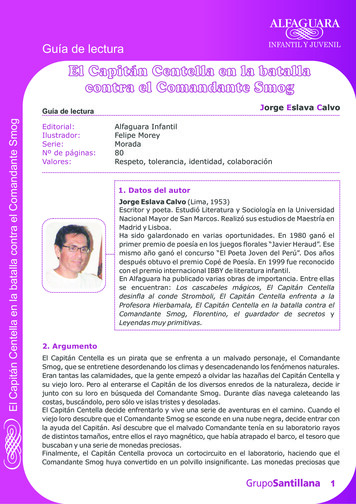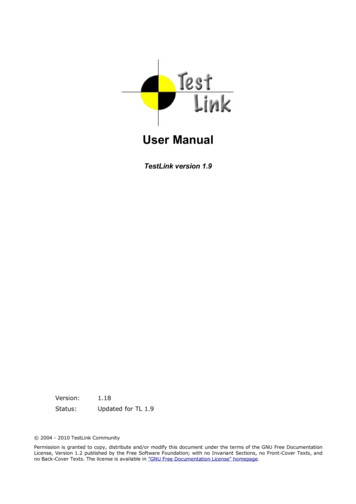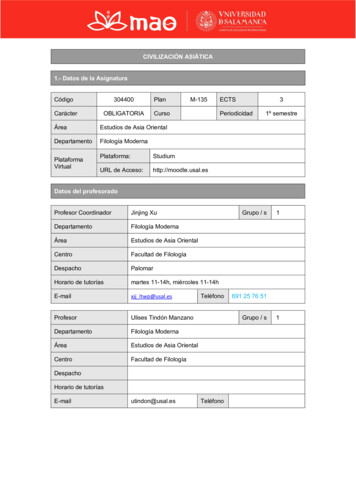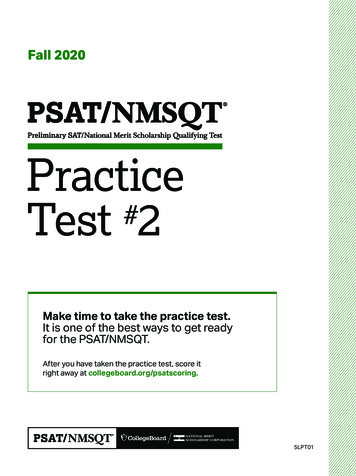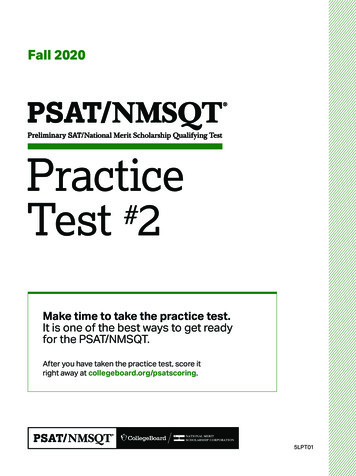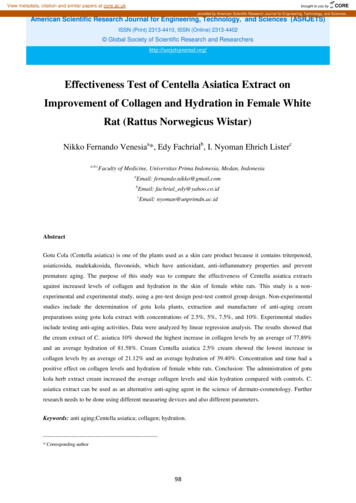
Transcription
View metadata, citation and similar papers at core.ac.ukbrought to you byCOREprovided by American Scientific Research Journal for Engineering, Technology, and Sciences.American Scientific Research Journal for Engineering, Technology, and Sciences (ASRJETS)ISSN (Print) 2313-4410, ISSN (Online) 2313-4402 Global Society of Scientific Research and Researchershttp://asrjetsjournal.org/Effectiveness Test of Centella Asiatica Extract onImprovement of Collagen and Hydration in Female WhiteRat (Rattus Norwegicus Wistar)Nikko Fernando Venesiaa*, Edy Fachrialb, I. Nyoman Ehrich Listerca,b,cFaculty of Medicine, Universitas Prima Indonesia, Medan, IndonesiaaEmail: fernando.nikko@gmail.combEmail: fachrial edy@yahoo.co.idcEmail: nyoman@unprimdn.ac.idAbstractGotu Cola (Centella asiatica) is one of the plants used as a skin care product because it contains triterpenoid,asiaticosida, madekakosida, flavonoids, which have antioxidant, anti-inflammatory properties and preventpremature aging. The purpose of this study was to compare the effectiveness of Centella asiatica extractsagainst increased levels of collagen and hydration in the skin of female white rats. This study is a nonexperimental and experimental study, using a pre-test design post-test control group design. Non-experimentalstudies include the determination of gotu kola plants, extraction and manufacture of anti-aging creampreparations using gotu kola extract with concentrations of 2.5%, 5%, 7.5%, and 10%. Experimental studiesinclude testing anti-aging activities. Data were analyzed by linear regression analysis. The results showed thatthe cream extract of C. asiatica 10% showed the highest increase in collagen levels by an average of 77.89%and an average hydration of 81.58%. Cream Centella asiatica 2.5% cream showed the lowest increase incollagen levels by an average of 21.12% and an average hydration of 39.40%. Concentration and time had apositive effect on collagen levels and hydration of female white rats. Conclusion: The administration of gotukola herb extract cream increased the average collagen levels and skin hydration compared with controls. C.asiatica extract can be used as an alternative anti-aging agent in the science of dermato-cosmetology. Furtherresearch needs to be done using different measuring devices and also different parameters.Keywords: anti aging;Centella asiatica; collagen; -------------------------------* Corresponding author98
American Scientific Research Journal for Engineering, Technology, and Sciences (ASRJETS) (2020) Volume 65, No 1, pp 98-1071. IntroductionThe skin is the biggest organ and serves to protect the body from the external environment such as shock,temperature, ultraviolet radiation, chemical and other threat. The skin consists of three layers, namely epidermiswhich functions as a liquid binder, a protector from foreign invasion, as a sensory organ, giving color to the skinand protecting internal organ, then the dermis layer that functions as regulating body temperature, providingmoisture to the skin, and as a sensory place on the skin, and then subcutaneous fat tissue that functions as aprotector from heat and cold and as a center for energy storage [1:50-54]. Change in the skin can be recognizedas a visual information and is associated with the aging process. The aging factor from the perspective of beautyis a decrease in skin texture, appearance of fine line and wrinkle, decrease elasticity and resilience, loss of skintexture that is elastic and supple and decreased skin function.1 The aging process in human can be divided into 2factors, namely intrinsic factor consisting of age, sex, hormone, and immune process as well as extrinsic factorsuch as trauma, free radical, and UV ray [1:50-54]. The sun's ultraviolet ray is the main extrinsic factor causingskin aging or photoaging, through the formation of free radical. The skin that undergoes photoaging willexperience an increase in inflammatory mediator, increase collagen degradation, decrease collagen synthesis,and increase elastotic tissue which will cause effect in the form of wrinkle, reduce collagen synthesis and reduceskin elasticity. Antiaging agent that is often used to reduce the effect of free radical is antioxidant that can beobtained through the outside of the body (exogenous antioxidant), one of which is through plants [2:1-17]. Skincare product made from herb has increased demand in the world market and is an invaluable gift of nature.Herbal formulation always attracts attention because of good activity and side effect that is relatively less ornothing with synthetic drug. Skin care product made from herb is defined as beauty product that has desiredphysiological activities such as healing, smoothing, improving skin condition. But, the use of synthetic producthas been very dangerous for a long time for young people and our environment. Various synthetic compound,chemical, dye and their derivative are proven to cause various skin diseases that have many side effects. So, thesolution is to use herbal skin care product as much as possible. A good skin care product must have varieties ofproperties such as antioxidant, anti-inflammatory, antiseptic, emollient, anti-seborrheic, antikerolytic andantibacterial activity. Herbal skin care product developed to reduce wrinkle, fight acne and control excess oil[3:1495-1497]. One of the herb that can be used as a skin care product now is gotu kola herb as well as being anherb that has antioxidant, gotu kola is also a plant that is easy to find and has various benefits such as antiinflammatory and detoxification [2:1-17]. Gotu kola itself has different names depend on the place of origin. InWest Java, it is called antanan. In Jakarta and Aceh, the name of it is gotu kola, Sumatran people call it as ahorse leg plant, There are many more local gotu kola names, such as kori-kori in Halmahera, pegago in theMinangkabau area, dogauke or sandanan or gogauke in the Papua region, and bebile in the Lombok area . Thename of gotu kola in several countries include gotu kola in Sri Lanka, takip-kohot in the Philippines, penny wortin England, brahma butu in India, penny wort in England and in China known as ji xue cao, while in France it isknown by the name bevilaque, hydrocote d'Asie, or cotyiole asiatique [4:121-130]. Gotu kola plant (Centellaasiatica) contains active compound flavonoid and triterpenoid that function as antioxidant [5:1-9]. The effect isassociated with increased collagen content on the skin [6:46-49]. Collagen level is the most commonly usedanti-aging parameter. In addition, anti-aging parameter can also use sensitivity, moisture content, elasticity, andpore size [7:1-7]. In this study, the effectiveness of gotu kola extract will be tested on female white mice99
American Scientific Research Journal for Engineering, Technology, and Sciences (ASRJETS) (2020) Volume 65, No 1, pp 98-107because it is suspected that there is an anti aging effect of gotu kola and hormonal effect that can strengthen theanti aging effect.2. Material and Method2.1.Research locationThe study was conducted from February to April 2019 at the Center for Animal Development for NorthSumatra Research.2.2.Experimental designThe type of research is a non-experimental and experimental research, using a pre-test design post test controlgroup design. Non-experimental studies include the determination of gotu kola plant, extraction andmanufacture of anti-aging cream preparation using gotu kola extract with concentration of 2.5%, 5%, 7.5%, and10%. Experimental research includes testing anti aging activity. Anti aging activity testing was carried out on25 white rats with 6-8 weeks of age and weight 150-200 mg.2.3.Implementation methodMaking gotu kola extra: Gotu kola plants from Purbalingga are dried and then made into powder using ablender. Gotu kola plant powder (Centella asiatica) weighed 100 grams then macerated with 400 ml of 70%ethanol for 24 hours with stirring. After maceration treatment the solution is then filtered using vacuum andfilter paper to separate the pulp and the filtrate, the filtrate is then separated to evaporate while the pulp isrecovered with a new solvent. This treatment is carried out three times or when the liquid extract is clear. Thefiltrate is then evaporated with a rotary evaporator at 60’C, so that a thick extract is obtained from gotu kolaplants. Phytochemical examination: alkaloid examination, tannin examination, saponin examination,triterphenoid examination, flavonoid examination, glycoside examination. Cream formulation: Creampreparation is made based on a standard formula that uses a basic type of oil in water cream:Table 1: Cream Formulation [8:10-11]CompositionConcentrationP0P1P2P3P4C. asiatica extract-2,5%5%7,5%10%Strearat 0,75Natrium dAd5050505050Gotu kola extract concentrations used in the manufacture of anti-aging cream preparation are 2.5%, 5%, 7.5%,100
American Scientific Research Journal for Engineering, Technology, and Sciences (ASRJETS) (2020) Volume 65, No 1, pp 98-107and 10% of the basic formulation of the cream without gotu kola extract is made as a placebo. Creampreparation: Stearic acid oil phase and aqueous phase (triethanolamine, glycerin, sodium benzoate and distilledwater) each melted in a porcelain cup over a temperature of 70’C. The oil phase is poured into the water phase,stirring in warm to cold mortars. The ingredients for each treatment are poured into another mortar, then addeda cream base little by little, while stirring until homogeneous.Testing anti-aging activity: Testing anti-agingactivity using 25 samples of female mice and divided into 5 groups:Group 1 (KN): 5 female rats for cream A (Blank)Group 2 (P1): 5 female rats for cream B (Extract 2.5%)Group 3 (P2): 5 female rats for cream C (Extract 5% )Group 4 (P3): 5 female rats for cream D (Extract 7.5%)Group 5 (P4): 5 female rats for cream E (Extract 10%)The entire group of rats are previously dried in the sun for 5 days for 4 hours (9:00 to 13:00), then, the fur isshaved on the back area of 2x2 cm2 using an electric shaver and a manual hair shaver. Then, measure thecondition of the test animals before treatment according to research conducted by Surjanto with a Skin AnalyzerEH 900 U including water content and collagen content. After measuring the initial skin condition, treatment isstarted by applying a thin and evenly applied cream to an area that has been marked, applying cream based onthe group specified above, applying it twice a day for 4 weeks. Changes in skin condition are measured every 1week for 4 weeks using a skin analyzer [ 9:99-104].2.4.Data analysisThe anti aging activity data of Centella asiatica extract is analyzed by the SPSS 25 program. The data are testedfor normality by the Shapiro-Wilk test and homogeneity is tested by the Levene’s test. If the data is normal andhomogeneous, the data is then tested with the Repeated Anova Test, followed by the Pearson correlation testand Multiple Linear Regression. If the data are not normal, use the Kruskal-Wallis test analysis followed by theMann-Whitney test and the Multiple Linear Regression Test.3. Result3.1.Description of phytochemical test resultPhytochemical test result on Centella asiatica extract is presented in Table 2.101
American Scientific Research Journal for Engineering, Technology, and Sciences (ASRJETS) (2020) Volume 65, No 1, pp 98-107Table 2: Phytochemical test results of Centella asiatica extract3.2.No.ParameterResultSign1AlkaloidPositive 2TaninPositive 3SaponinPositive 4Triterpen/SteroidPositive 5FlavonoidPositive 6GlikosidaPositive CollagenThe result of examination of collagen level in the skin of female white rats smeared with Centella asiaticaextract cream is shown in Table 3.Table 3: Collagen levels of female white rat skin after being centrelated with Centella asiatica extract 27,2P1 (2,5%)39,841,844,446,248,221,12P2 (5%)38,44245,449,65543,2P3 (7,5%)39,645,851,256,263,257,54P4 (10%)3948,853,460,868,877,89FormulaBeforeP0 (kontrol)Explanation:Normal 25-50%; Good 50-65%; Very Good 65-80%P: FormulaP0: ControlP1: Gotu kola herb extract cream 2.5%P2: Gotu kola herbal extract 5%P3: Gotu kola herb extract 7.5%P4: Gotu kola herb extract 10%102% Collagen increasement
American Scientific Research Journal for Engineering, Technology, and Sciences (ASRJETS) (2020) Volume 65, No 1, pp 98-107Kadar Collagen level in all groups of rats before applying gotu kola herb extract cream is 35-42 (normal). Afterrubbing with gotu kola herb extract cream and with gotu kola herb extract for four weeks, cream with gotu kolaextract or cream without extract of gotu kola herb showed an increase in collagen level. The application ofcream with or without Centella asiatica extract for 4 weeks together increases the collagen levels of the skin offemale white rats. However, cream with Centella asiatica extract 10% shows the highest increase in collagenlevel by an average of 77.89% with an average final value of 68.8 (very good). Whereas, cream with Centellaasiatica 2.5% extract shows the lowest increase in collagen level by an average of 21.12% with an average finalvalue of 48.2 (good), when compared to other Centella asiatica extract cream (5%, 7.5%, 10%). Whereas, thecream without Centella asiatica shows an increase in collagen level by an average of 7.2% with an average finalscore of 41.2 (normal) for four weeks of treatment.3.3.HidrationResult of examination of hydration level in the skin of female white rats smeared with Centella asiatica extractcream is shown in Table 4.Table 4: Hydration levels (water) of female white rat skin after being applied with Centella asiatica ment27,429,631,632,634,225,18P1 (2,5%)27,630,232,235,237,439,4P2 (5%)2629,433374264,03P3 (7,5%)28,233,439,845,65074,71P4 reExplanation:Dry: 3-4%; Less: 4-10%; Normal: 10-15%; Height: 15-30%; Very high: 30%P: FormulaP0: ControlP1: Gotu kola herb extract cream 2.5%P2: Gotu kola herbal extract 5%103Hydration
American Scientific Research Journal for Engineering, Technology, and Sciences (ASRJETS) (2020) Volume 65, No 1, pp 98-107P3: Gotu kola herb extract 7.5%P4: Gotu kola herb extract 10%Hydration level in all groups of female white rats before applying the gotu kola herb extract cream is 22-31(high). After applying with Centella asiatica herbal extract cream or with cream without Centella asiatica extractfor four weeks, cream with extract or cream without Centella asiatica extract shows an increase in hydrationlevels. The application of cream with or without Centella asiatica extract both increases hydration level duringthe four weeks of treatment. However, cream with Centella asiatica 10% extract shows the highest increase inhydration level by an average of 81.58% with an average final value of 51.6 (very high). Whereas, cream withCentella asiatica 2.5% extract shows the lowest increase in elasticity level by an average of 39.40% with anaverage final value of 37.4 (very high), when compared to other Centella asiatica extract cream (5%, 7.5% ,10%). Whereas, the cream without Centella asiatica shows an increase in hydration level by an average of25.18% with an average final score of 34.2 (high) for four weeks of treatment.4. Discussion4.1.The Effect of Centella asiatica extract cream on collagen levelApplication of cream with or without Centella asiatica extract for 4 weeks together increases the collagen levelof the skin of female white rats. The result of this study is consistent with research conducted by Lee and hiscolleagues [10:324-329] who observed that Centella asiatica preparation can stimulate fibroblast proliferationand activate SMAD signaling pathways so as to increase type I collagen production and reduce the formation ofstretch marks and inflammatory reaction. In addition, the constituent isolated from C. asiatica can improveblood circulation in the skin and prevent excessive accumulation of fat in cell. Binding induced asiaticosidefrom SMAD 3 and SMAD 4. In consistent use, complex nuclear translocation of SMAD 3 and SMAD 4 isinduced through treatment with asiaticoside, indicating there is involvement of asiaticoside in Smad signaling.In addition a TGFbeta receptor I (TbetaRI) kinase inhibitor, known as an SMAD pathway activator, is not foundto inhibit Smad 2 phosphorylation synthesis and Type 1 collagen synthesis induced by asiaticoside. On thisstudy shows that asiaticoside in C. asiatica can induce synthesis of type I collagen through activation of theTbetaRI kinase-independent SMAD pathway. As for cosmetic purposes, Centella asiatica is used as an activecompound in skin care preparation because of its antioxidant, anti-inflammatory, anti-cellulite, and antiagingactivities. Therefore, Centella asiatica extract which is rich in triterpenes is a valuable raw material with a broadspectrum of cosmetic action. The result of a study conducted by Hashim Lee and his colleagues [11:1310-1322]who looked at the effects of the triterphenoid composition and bioactivity of C. asiatica compared with VitaminC showed that the extract of C. asiatica showed a stimulatory effect on collagen synthesis in doses that weredependent on the treatment method. Data are expressed as μg collagen synthesized per 100 μg of total cellularprotein to standardize the total number of cell from each plate. Vitamin C (25 μg / mL) used as a positivecontrol showed a 2-fold collagen enhancer response. At 50 mg / mL Centella extract increased collagenproduction 3-fold compared to the (untreated) control, whereas at 30 mg / mL and 10 mg / mL collagenincreased 2 and 1.4 times respectively. Centella extract at concentrations higher than 50 mg / mL, cell viabilitydecreases (data not shown). The result obtained is in accordance with previous studies in which triterpenes104
American Scientific Research Journal for Engineering, Technology, and Sciences (ASRJETS) (2020) Volume 65, No 1, pp 98-107extracted from Centella stimulate collagen synthesis. In the cosmetics world, C. asiatica has been used as aneffective anti-photoaging agent, mainly due to an increase in type I collagen, which amounts for aging decreaseswith age. This action was confirmed in a double randomized clinical trial conducted by Haftek Lee and hiscolleagues [12:946-952] among 20 female participants (45-60 years old) with skin photaging to examine theimpact of 0.1% madecassoside applied topically in mixed with 5% vitamin C on their skin. Six-month treatmentresulted in a significant increase in skin firmness, elasticity and hydration, as well as the level of collagen thatwas confirmed by biometrology tests. It is thought that the beneficial effect of C. asiatica on improving skincondition is due to madecassoside, an induction of collagen expression that is known by activating the SMADsignaling pathway. In previous studies, the same researchers confirmed the beneficial effect of 5% vitamin C onphotoaging skin, which results from stimulation of collagen synthesis in fibroblasts and matrixmetalloproteinase control which is responsible for collagen degradation, whereas in skin with photoaging, thelevel of vitamin C in tissue significantly reduced. Thus, it can be concluded that a mixture of vitamin C andmadecassoside is an interesting combination of two active compounds that are characterized by a mechanismdifferent activities, which provide an additive or synergistic effect. In research conducted by Farage, Miller,Elsner, & Maibach [13:87-95] shows that Collagen is influenced by extrinsic and intrinsic factors. Intrinsicfactor includes genetic factor and hormone such as estrogen, extrinsic factor includes ultraviolet light, pollution,and diet. Estrogen can increase collagen synthesis. Menopausal women experience a significant decrease incollagen level. In human, estrogen is also associated with an overall increase in the deposition of collagenduring the remodeling phase. This suggest estrogen can affect the balance between collagen synthesis anddegradation and research has shown that although aging is associated with increased expression of MatrixMetallo Proteinase (MMP), specifically MMP-2 and MMP-9, staining for MMP-9 is most evident in olderwomen, show that estrogen reduction that occurs postmenopausal can affect proteinase production [14-264270].4.2.The Effect of Centella asiatica cream extract on hydration levelThe application of cream with or without Centella asiatica extract both increases hydration level during the fourweeks of treatment. The result of this study is consistent with research conducted by Saraf, Chhabra, Kaur, &Saraf (2012) which shows that there are increased levels of hydration, sebum, viscoelasticity and decreasedlevels of melanin in the use of herbal creams with the basic ingredients of C. asiatica (1-5% w/w) caused by theeffects of active constituents (polyphenols and glycosides) contained in hydroethanolic extract from selectedherbs that function as antioxidant, anti-elastase, antiproliferative, photochemoprotective, antipyretic, antiallergic, astringent, facemask-toning, and anti-aging. Hydroalcoholic extract from C. asiatica is used to makeherbal cream along with four medicinal plant (Curcuma caesia, Areca catechu, Cinnamon zeylanicum andTamarindus indica) [15:119-131]. Another study is comparing the administration of Centella asiatica with theMicroneedle Therapy System (MTS) method on the right face (experimental group) and the administration ofhyaluronic acid as a control group on the left face (control group) in 14 women for 8 weeks on increasing levelof hydration, shows that a significant increase in skin hydration level is found in both the experimental andcontrol groups (p .0001) [16:787-794]. In a study conducted by Milani, Sparavigna, Cooper, Pertusella, &Varese (2017) who looked at the comparison of skin barrier function and skin hydration for 24 hours onmoisturizers with 1% hyaluronic, Glycerin 5% and C. asiatica extract with the control group found that there is105
American Scientific Research Journal for Engineering, Technology, and Sciences (ASRJETS) (2020) Volume 65, No 1, pp 98-107an increase in skin hydration ( 59% after 1 hour, 48% after 8 hours, and 29% after 24 hours) comparedwith the control group. This is because HA and glycerin are substances that are believed to increase skinhydration because they play a role in skin reepitalization and increase the proliferation and activity ofkeratinocytes and C. asiatica extract is rich in amino acid, flavonoid, terpenoid, essential oil and alkaloid. C.asiatica extract can inhibit the activity of the hyaluronidase enzyme and prolong the effect of HA [17:311-315].This is consistent with research conducted by Nema, Maity, Sarkar, & Mukherjee (2013) who see an inhibitoryeffect of hyaluronidase, metalloproteinase and elastase on C. asiatica extract by assessing enzymatic activitywith ursolic acid and oleanolic acid. As a result, C. asiatica extract has significant inhibitory activity namelyIC50 27.00 0.43 and 18.63 0.33 µg/mL in hyaluronidase and elastase IC50 29.15 0.31 and 19.45 0.25 µg / mL. This proves that the extract C. asiatica can be used as an anti-aging agent [18:1182-1187].5. ConclusionCream of C. asiatica extract 10% shows the highest increase in collagen level by an average of 77.89% and anaverage hydration of 81.58%. Cream Centella asiatica 2.5% cream showed the lowest increase in collagen levelby an average of 21.12% and an average hydration of 39.40%. Conclusion: The administration of gotu kola herbextract cream increased the average collagen level and skin hydration compared to control, positively correlatedwith the increase in duration of gotu kola extract cream and the amount of gotu kola extract given. Gotu kolaextract can be used as an alternative anti aging agent in the science of dermato-cosmetology. Further researchneeds to be done using different measuring devices and also different parameters.References[1].Yagi, M., & Yonei, Y. “Glycative stress and anti-aging: What is glycative stress?”. Glycative StressResearch, vol. 5, pp 50-54, Sep. 2016.[2].Jadoon S., Karim S., Hassham M., Bin H., Akram M. R., Khan A. K., Malik A, Chen C, and Murtaza,G. "Anti-Aging Potential of Phytoextract Loaded-Pharmaceutical Creams for Human Skin CellLongetivity". Hindawi Publishing Coorporation. vol. 1, pp1-17, Mar. 2015.[3].Mali A. S., Karekar P., and Yadav A. V. 2015. "Formulation and Evaluation of Multipurpose HerbalCream". International Journal of Science and Research, Vol. 4(11), pp. 1495-1497, Nov.2015.[4].Sutardi. "Kandungan Bahan Aktif Tanaman Pegagan dan Khasiatnya unuk Memingkatkan SistemImun Tubuh". Jurnal Litbang Petanian, Vol. 35(2). pp.121-130, 2016.[5].Yasurin P. ”Review : The Bioavailability Activity of Centella asiatica Review : The BioavailabilityActivity of Centella asiatica". KMUTNB Int J Appl Sci Technol, vol. 9, no. 1, pp. 1–9, Jan.–Mar.2016.[6].Bylka W., Znajdek-awiżeń P., Studzińska-sroka E., and Brzezińska M. (2013). "Centella asiatica incosmetology”. Postep Derm Allergol, vol. 30, pp. 46–49, 2013.[7].Badenhorst T., Svirskis D., Merrilees M. J., & Wu Z. "Effects of GHK-Cu on MMP and TIMPExpression , Collagen and Elastin Production , and Facial Wrinkle Parameters". Journal of AgingScience, Vol. 4, pp. 1–7, jan. 2016.[8].Sharma G. K., Gadiya J., and Meenakshi Dhanawat. A Textbook of Cosmetic Formulations (eBook)106
American Scientific Research Journal for Engineering, Technology, and Sciences (ASRJETS) (2020) Volume 65, No 1, pp 98-107Formulation and Evaluation of Cosmetics. India, Kbuuk Publication, 2016, pp.10-11.[9].Surjanto, Reveny J, Tanuwijaya J, Tias A, Calson. "Comparison of Anti-Aging Effect BetweenVitamin B3 and Provitamin B5 Using Skin Analyzer". International Journal of Pharma TechResearch.Vol. 9(7): p. 99-104, 2016.[10]. Jongsung L., Eunsun J., Youngji K., Junho P., Jinil P., Sungtaek H., Jieun K., Changgu H., Yeong ShikK., and Deokhoon P. "Asiaticoside Induces Human Collagen I Synthesis through TGFβ Receptor IKinase (TβRI Kinase)-Independent Smad Signaling". Biochemistry and Molecular Biology, vol. 72(4),pp. 324–328, 2006.[11]. Hashim P., Sidek H., Helan, M. H. M., Sabery A., Palanisamy U. D., and Ilham, M. "TriterpeneComposition and Bioactivities of Centella asiatica". Molecules, vol. 16, pp. 1310–1322, Jan. 2011.[12]. Haftek M., Mac‐ Mary S., Bitoux M. Le, Creidi P., Seité S., Rougier A., and Humbert P. "Clinical,biometric and structural evaluation of the long‐ term effects of a topical treatment with ascorbic acidand madecassoside in photoaged human skin". Wiley Online Library, vol. 17pp. 946-952. Oct. 2008.[13]. Farage M. A., Miller K. W., Elsner P., and Maibach H. I. "Intrinsic and extrinsic factors in skin ageing:a review". Wiley Online Library, vol. 30, pp.87-95 . Sep. 2007.[14]. Thornton M. J. "Estrogens and aging skin". Dermato-Endocrinology, vol. 5(2), pp. 264–270, Apr.-Jun.2013.[15]. Saraf S., Chhabra S., Kaur C.,and Saraf S. "Development of photochemoprotective herbs containingcosmetic formulations for improving skin properties". Journal of Cosmetic Science, vol. 63(2),pp.119–131, Mar.-Apr. 2012.[16]. Choi S., and Bae H. "The Effects of Centella Asiatica Extract and Microneedle Therapy System on theWomen ’ s Facial Skin". Korean Journal Aesthetic and Cosmetology, vol. 11(4), pp.787–794, 2013.[17]. Milani M., Sparavigna A., Cooper D., Pertusella C., and Varese. "The 24-hour skin hydration andbarrier function effects of a hyaluronic 1%, glycerin 5%, and Centella asiatica stem cells extractmoisturizing fluid: an intra-subject, randomized, assessor-blinded study". Clinical, Cosmetic andInvestigational Dermatology, vol. 10, pp. 311–315, 2017.[18]. Nema N.K., Maity N., Sarkar B.K., and Mukherjee P.K. (2013). "Matrix metalloproteinase,hyaluronidase and elastase inhibitory potential of standardized extract of Centella asiatica".Pharmaceutical Biology, vol. 51(9), pp. 1182-1187, Jun. 2013.107
and increase elastotic tissue which will cause effect in the form of wrinkle, reduce collagen synthesis and reduce skin elasticity. Antiaging agent that is often used to reduce the effect of free radical is antioxidant that can be obtained through the outside of the body (exogenous antioxidant), one of which is through plants [2:1-17]. Skin
